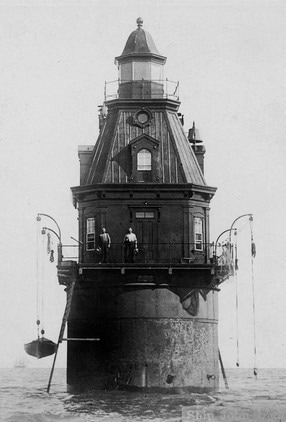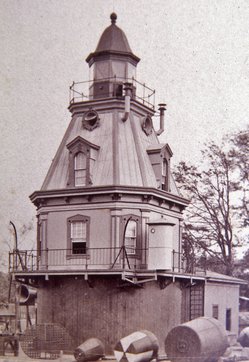 At a point just below where the Delaware River becomes Delaware Bay there is a treacherous shoal opposite the mouth of the Cohansey River in New Jersey. In 1797 the ship “John” came to grief there and as result it has been known as Ship John Shoal ever since. By the mid-nineteenth century the US government finally decided to mark the dangerous shoal with a lighthouse. After a false start in 1856 a light was finally placed on Ship John Shoal in 1877. An iron caisson that would serve as a base for the lighthouse was sunk on the shoal in 1874 and filled with concrete. Upon this in 1877 was placed the iron lighthouse superstructure that has an octagonal first story containing the living quarters and kitchen for the lighthouse keeper and his assistants. This was surmounted by a tall mansard roof containing bedrooms for the crew and the watch room. The steep sloped roof was reputedly designed to collect rain water to replenish the fresh water supply in the station’s cisterns. Above the roof was placed the lantern room housing the light. Architecturally the structure is a Second Empire High-Victorian edifice with a walkway/platform surrounding the first floor complete with two sets of davits for launching boats and a privy. A fog bell was mounted atop on of the dormers on the tall roof. With it’s iron pre-fab construction featuring heavily molded cornice, brackets, portholes and ornate window casings the structure exudes a nautical look reminiscent of illustrations from Jules Verne’s novels; essentially steam-punk in the middle of Delaware Bay. Prior to being placed on station on the bay, the lighthouse superstructure spent the summer of 1876 as the centerpiece of the U.S. Lighthouse Establishment’s exhibit at the Centennial Exposition in Philadelphia. At about the same time an identical structure was placed on station on the East side of the entrance of the harbor at New Haven, CT. Known as Southwest Ledge Light it was first lit on January 1, 1877. I have always been fascinated by this structure since I came across a photo of it in an article on New Jersey Lighthouses in an old school bulletin published by the Federal Writers Project of the Works Progress Administration in 1937. I began to collect photos of the light and talked to many folks familiar with it. One old-timer from Bridgeton, NJ spoke of how during a cold winter when the bay froze over in the 1920s, a guy drove his car out over the ice to the lighthouse.
In 1973 the station was automated and in 1997 it was solarized which precluded the need for diesel generators to power the light. In June 2011 the Coast Guard declared the light to be unnecessary and to be made available for public sale. It was sold at auction on November 11, 2012 for $60,200. Ship John can be seen from Bayside or Seabreeze, NJ, or from Woodland Beach Delaware. Be sure to take along a pair of binoculars. The figurehead of the ship “John” was preserved and was on display at the lighthouse which at one time attracted many visitors by boat. The figure head along with the fog bell are now on display at the Gibbon House museum in Greenwich , NJ. The original lens from the lighthouse is on display at the U.S.Coast Guard Air Station at Pomona, NJ.
1 Comment
|
Get to know us!Here's where we post new products, stuff we want to share, and the occasional joke. Archives
September 2017
Categories
All
|




 RSS Feed
RSS Feed
